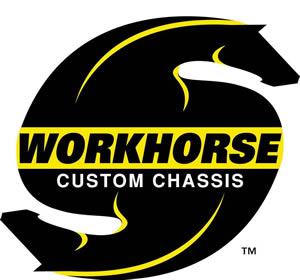Brake-Friendly Driving Technique Tested in Death Valley
This article provided by the Workhorse Chassis Technical Team
On a trip to California the Workhorse Chassis Technical Team made notes on driving technique when descending a mountain pass in Death Valley.
Background:
The motor home was built on a Workhorse W22 gas chassis, fully laden to 22,000 lb. GVWR. The driver, let's call him Mike, is an experienced driver with a valid Commercial Driver's License and is also a professional automotive technician. We asked Mike to drive the vehicle in a fashion that would conserve the brakes, but also be reasonable in using the engine and transmission for braking (i.e. drive it like you own it!).
We were traveling in a south-westerly direction into Death Valley National Park from the Nevada side on SR-374, with a planned stop at Stovepipe Wells Village in the park. This is quite a steep descent with almost 10 miles of 7 percent grade and 4 miles of 5 percent grade, with a total drop of around 4,000 foot over 12 miles of driving. The speed limit on some road sections inside the National Park on this road is 45 mph, so Mike shifted down to second gear as soon as we hit the down-grade. The motor home was a 2005 model with the 5 speed Allison transmission and equipped with the 'Grade-Brake' feature, but Mike elected not to use the Grade Brake, instead preferring to manually shift down using the column shift.
 Mike would allow the vehicle to run against engine compression with the engine speed varying between 4,000 rpm to 5,200 rpm, depending on the grade. Each time we hit 5,200 rpm the transmission would force a shift to 3rd in order to protect the engine. Each time this happened Mike applied the brake for a few seconds to scrub off speed and this allowed the transmission to downshift to 2nd gear again, allowing maximum engine braking in the safe speed range. Drivers should not be concerned about the high rpms in this situation because, as noted, the transmission will automatically adjust when needed to protect the engine. Also, if Mike had elected to use the Grade Brake feature, the down- and up-shifting would have happened automatically once he touched the brake pedal.
Mike would allow the vehicle to run against engine compression with the engine speed varying between 4,000 rpm to 5,200 rpm, depending on the grade. Each time we hit 5,200 rpm the transmission would force a shift to 3rd in order to protect the engine. Each time this happened Mike applied the brake for a few seconds to scrub off speed and this allowed the transmission to downshift to 2nd gear again, allowing maximum engine braking in the safe speed range. Drivers should not be concerned about the high rpms in this situation because, as noted, the transmission will automatically adjust when needed to protect the engine. Also, if Mike had elected to use the Grade Brake feature, the down- and up-shifting would have happened automatically once he touched the brake pedal.
Overall, Mike applied the brake only seven times during the 14-mile descent and this includes the final stop at the T-junction with the North Highway! Most of the applications were of short duration, with less than 5 seconds of brake pedal application required to control the vehicle speed.
Only once did Mike use the brake pedal for longer on a twisty section to ensure we remained at a safe speed. The total time of brake application was only around 45 seconds. This was quite an enlightening illustration of how driving technique learned on heavy trucks can allow for safe navigation of the most demanding descents with no danger of overheating and damaging the brakes on your motor home.
You may also want to read: Mountain driving: Let your engine do the Braking


